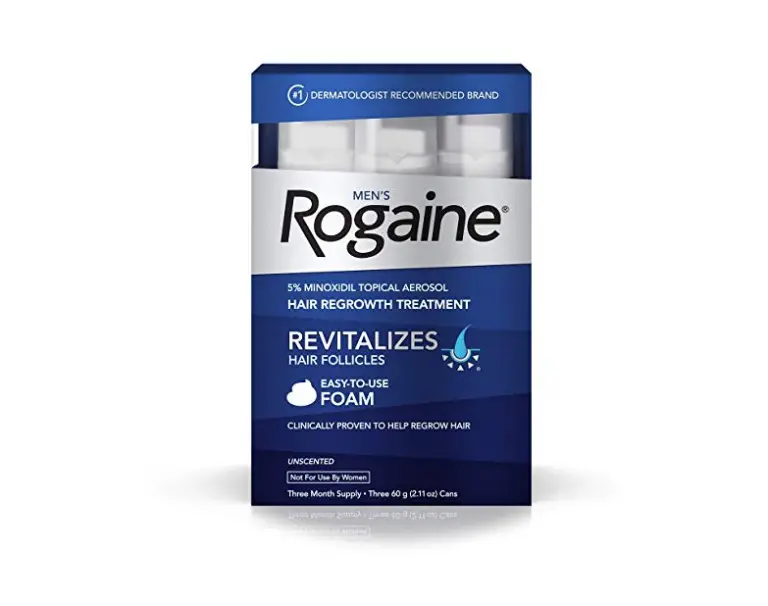
Page Contents
If you are trying to find out if Rogaine might be the right hair loss treatment for you, one of the most important questions is: How does Rogaine work?
The short answer is that Rogaine works primarily by increasing the blood circulation in your scalp. This has a domino effect, helping your hair growth in many ways.
If you want to know more about how Rogaine works and how increased circulation can be helpful, I hope you’ll keep reading. There are some concerns about how increased blood flow can negatively affect you.
What Rogaine Says
On their website, Rogaine has a tab titled: How Rogaine® Works. This tab begins by stating they are FDA-approved to treat hair loss by stimulating your hair follicles to allow you to grow thicker hair.
Next, they say that their Minoxidil is formulated with Tricho-Prime® Technology. I wasn’t able to find information on that type of technology or what its advantages are.
Rogaine then says that Minoxidil increases your hair follicle size to extend your hair growth cycle. A longer cycle allows thicker hair growth.
DHT shrinks your hair follicle by latching onto the cells and causing blockage. Therefore, any DHT blocker can increase your hair follicle size if it can remove this blockage. Increased blood flow should help with this removal.
After that, Rogaine explains there are different causes of hair loss, tells you it should be treated as soon as possible, and then that Rogaine can lengthen your hair’s active growth phase.
Rogaine then tells you how many people have benefited from using their product and that you need to use it for at least three to four months.
The Rogaine site gives a better answer in their FAQ section, where they have the question: How do Rogaine products work?
They first go over different causes of hair loss, then state: “The exact mechanism of action for ROGAINE® products is uncertain. However, researchers believe that ROGAINE® products works by enlarging the hair follicles and reversing miniaturization. By enlarging miniaturized follicles, the growth phase of the hair cycle is prolonged, allowing the hair to become longer and thicker looking.”
This is a good explanation, but it doesn’t answer exactly how it enlarges your hair follicles.
Some Minoxidil History
Minoxidil was developed in the 1960s, first as a way to treat stomach ulcers in dogs, according to Wikipedia. Though it didn’t work for that, these tests found it was a good vasodilator. This medical term means it increases blood flow by dilating (making bigger) a person’s blood vessels.
Dilated blood vessels make for lower blood pressure and reduce strain on the heart. Because of that, Minoxidil was tested to see if it had potential to help with high blood pressure. It was during these tests that those conducting the studies noticed that many participants had better hair growth.
That naturally caused Minoxidil to be tested specifically for hair loss. These tests showed great results, and in 1988 Minoxidil became one of the first FDA-approved treatments for hair loss.
How Increased Blood Flow Can Cause Hair Regrowth
Each hair follicle needs to receive nutrients in order to cause its hair strand to grow. Your hair strands are made of proteins, primarily keratin, and a few other things. If your hair follicle can’t get these nutrients, it can’t put them together to build your hair strand.
Your hair follicles also need to be nourished themselves. Like every other part of your body, they need to receive oxygen and to have their natural waste removed. When this doesn’t happen, the waste your cells make can build up there.
This means that your follicles become both starved and damaged from this buildup. Eventually, your follicles will try to reduce the amount of nutrients they need and the waste they make by going dormant. When a follicle decides to do this, its hair will fall out.
Even dormant follicles still need some blood flow, though, and continued lack of this can kill the hair follicle. By using Rogaine or some other method to increase the blood flow, your follicles can recover and start growing hair again.
Unfortunately, things like free radicals and DHT can attach themselves to cells in your scalp. These block up the pathways your blood takes to your follicles. The more blocked these pathways get, the less blood gets where it needs to be.
In some cases, increasing the blood flow in this type of situation allows your body to remove some of the blockage. Even if it can’t do that, it can at least get to your follicles the nutrients they need despite the blockage.
The Cautions Of This Method
Rogaine may work for hair loss and has been proven by over 100 studies by the National Library of Medicine to work for most people. However, this does not make it a perfect product. For starters, even applying Minoxidil only to your scalp still has an effect on blood vessels elsewhere in your body.
This can cause many side effects. Milder ones include excessive hair loss in other places you may not want it, headaches, itchiness, and a change in hair color.
More serious side effects of Rogaine include chest pain, heart palpitations, swelling in your extremities or face, sudden weight gain, dizziness, faintness, and dangerously low blood pressure. Rogaine tells you on their site to see your doctor immediately if Minoxidil gives you any of these symptoms.
Those on blood pressure medications of any type will probably have their doctor tell them to avoid taking Minoxidil. There are other medications that are incompatible with Minoxidil as well.
Also, a sudden change in your blood pressure can also affect your hair follicles by causing them to restart their growth cycle. Rogaine warns about this, telling new users to expect increased hair shedding before new hair growth starts.
This is not only very worrisome, but it can hide worsening hair loss. You won’t know if your hair loss is worse or if it is just the Rogaine working until months have passed.
Finally, opening your blood vessels may cause hair regrowth, even if you have a buildup of DHT. However, if the DHT or whatever else is clogging your blood vessels isn’t cleared, they may continue to build up. Eventually, even using a vasodilator won’t get enough blood to your follicles.
Final Thoughts
The fact that Rogaine increases blood flow means that it can help with more than male pattern baldness that is caused by DHT. Rogaine has a good record of helping people with hair loss, according to the clinical studies and customer reviews that have been done on it.
Unfortunately, side effects are also common due to how it works. There is also the fact that, if you stop using Rogaine, your follicles will eventually shrink to their former size. This will cause your hair to fall back out again, making you lose all your hair progress.
If you are familiar with Rogaine, perhaps you could let me know how Rogaine worked for you.


![50 Insane Facts About Hair [Infographic] Beautiful](https://hairlossgeeks.com/wp-content/uploads/2019/07/beautiful-2405131_1280-1.jpg)

![Does Smoking Weed Cause Hair Loss? [Marijuana And Hair Loss] Can Smoking Weed Cause Hair Loss](https://hairlossgeeks.com/wp-content/uploads/2017/11/Can-Smoking-Weed-Cause-Hair-Loss-100x70.jpeg)


